Understanding Color Streaks in Geology and Paleontology
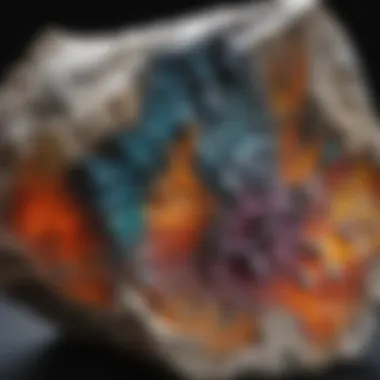
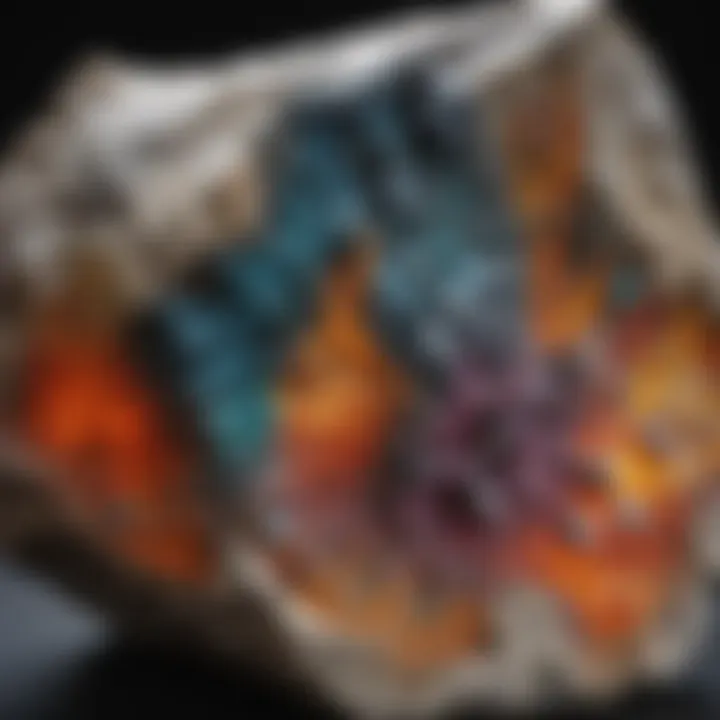
Intro
In the fascinating realms of geology and paleontology, color streaks serve as a gateway to deeper insights. These vibrant lines and hues can be the telltale signs of a specimen’s history, providing clues about its mineral makeup and authenticity. Collectors and enthusiasts alike have long been drawn to the allure of these streaks, which can transform a seemingly ordinary rock or fossil into a piece of natural art rich in stories.
Understanding color streaks goes beyond mere aesthetics. It's a journey through layers of time, revealing not just the geological processes that shaped the Earth but also the biological history captured in minerals. With this article, we intend to provide you, the reader, with a well-rounded perspective on how these enchanting features enhance the knowledge and appreciation of natural specimens.
Understanding Color Streaks
Color streaks serve as a vital thread in the fabric of geology and paleontology. They act as indicators that unlock a deeper understanding of the materials comprising natural specimens, revealing not just their mineral composition, but also the environmental processes that shaped them. When collectors examine these streaks, they're engaging with a history that spans eons.
A key takeaway here is that color streaks aren't just about aesthetics. They are pivotal in assessing authenticity and determining the origins of fossils and minerals. For enthusiasts, this dimension highlights the need for keen observation and education. As one dives into the signs present in these specimens, it becomes less about aesthetics and more about deciphering a story woven through time. Understanding color streaks builds appreciation and knowledge, essential for any collector or academic involved in these fields.
Definition of Color Streaks
Color streaks refer to the thin, colored bands or lines found on the surface of mineral specimens or fossils. These streaks can vary markedly in hue and intensity, influenced by factors like mineral content, environmental conditions during formation, and chemical reactions that may have occurred over the specimen’s lifespan. For example, iron oxides in rocks can result in vivid reds and yellows, while copper can create striking greens and blues.
In practical terms, the color streak can often be tested indirectly by scratching the mineral across a harder, unglazed tile (called a streak plate), allowing collectors to see the true color left behind. This fundamental test helps in identifying the mineral accurately, as some may appear different in bulk compared to their powdered form.
Historical Context
The fascination with color streaks is not a modern phenomenon. Historically, human beings have sought to make sense of the colorful world around them. Ancient cultures often attributed colors in stone and earth to divine intervention or the spirits of nature. For instance, Native American tribes used ochres for painting and ceremonial purposes, recognizing how color could convey meaning and connect with their beliefs about the world.
In geology, scientists like John Latham in the 1700s explored the concept of mineral coloration, laying foundational theories for modern geology. His early works prompted significant inquiry that led to classifying minerals based on color streaks and composition. These inquiries paved the way for later advancements and deeper explorations in both geology and paleontology. They solidified color streaks as critical components for identifying and analyzing geological samples as well as digested fossils, a trend that remains relevant today.
Formation of Color Streaks
Understanding how color streaks are formed gives valuable insight into the geological and paleontological narrative captured within natural specimens. This section dives into specific geological and chemical mechanisms that lay the groundwork for the vibrant streaks observed in rocks and fossils. Highlighting these factors not only enhances awareness of geological processes but also adds depth to the knowledge for rock and fossil collectors seeking to appreciate the stories behind their specimens.
Geological Processes
Sedimentary Processes
Sedimentary processes reveal themselves through the layering and deposition of minerals over time. These layers encapsulate varied hues and can indicate past environmental conditions. The key characteristic of sedimentary processes is their ability to encode history within compositions. As material is eroded, transported, and finally deposited, the resulting color streaks act as pages in a geological book, documenting events that span thousands or even millions of years.
The unique feature of these processes is the inherent variability in the materials being deposited. For example, iron oxides often produce striking reds and yellows, while organic matter can lead to deeper greens or browns. However, a disadvantage in studying sedimentary processes lies in the fact that their colors might not always represent original conditions but rather altered states through diagenetic processes.
Metamorphic Transformations
Metamorphic transformations occur under intense heat and pressure, causing pre-existing rock to redefine its structure, leading to remarkable color variations. A key characteristic here is the recrystallization of minerals, which can lead to incredible beauty and complexity. The fact that metamorphic colors often reflect high-grade conditions makes this an attractive area for geologists and collectors alike.
One unique aspect of metamorphosed rocks is the interplay of mineral grain sizes, which can create striking effects in color. However, a downside may be the difficulty of tracing the original mineral composition due to those transformations obscuring it. Understanding these transformations provides a clearer picture of regional geological history.
Volcanic Activity
Volcanic activity contributes significantly to color streaks, particularly when lavas cool into igneous formations. The rapid cooling of basalt, for instance, can produce a range of colors, from deep blacks to eye-catching reds or greens, depending on the minerals present. This variety makes volcanic materials captivating for geologists and collectors.
A notable trait of volcanic contributions is the potential for diverse mineral assemblages, often seen in tephra or volcanic ash layers. However, an important consideration is that the colors can be temporary, fading over time or due to weathering, thus complicating the authenticity assessment of specimens.
Chemical Reactions
Oxidation and Reduction
Chemical reactions play a vital role in the formation of color streaks. Oxidation and reduction processes often dictate the colors that appear as minerals undergo transformations in response to environmental changes. The significant aspect of these reactions is their ability to reveal underlying elemental compositions. For rock enthusiasts, noting these reactions can provide insights into the condition and history of the specimen.
The unique feature here is the vibrant reds and oranges that emerge from oxidized iron, a common mineral present in many rocks. However, the downside is that these colors might not always indicate the quality of the specimen—frequently, they could be surface phenomena that mislead collectors.
Mineral Weathering
The weathering of minerals is another process that contributes to color streaks, often leaving behind beautiful highlights as elements break down. The key characteristic of mineral weathering is its gradual nature, which allows for the formation of unique patinas. For collectors, understanding the effects of weathering can further knowledge about the specimen's age and ecological history.
What sets this phenomenon apart is the sustainability of color; as minerals weather over time, they can create hues that tell tales of ancient environments. On the contrary, mineral weathering can sometimes produce misleading coloration, which may not faithfully represent the specimen’s original state.
Elemental Variation
Elemental variation reflects the diverse mix of elements that can influence the color profiles of geological specimens. This aspect has direct implications on the aesthetics and value of the specimens. A distinctive characteristic is the spectrum of colors that can arise from the same rock type, influenced by variations in elemental presence.
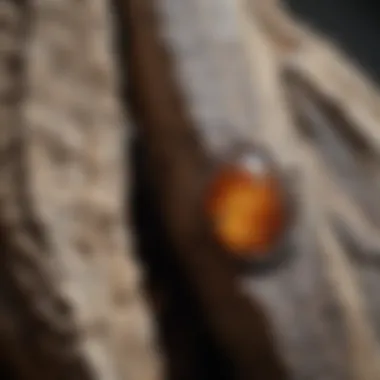
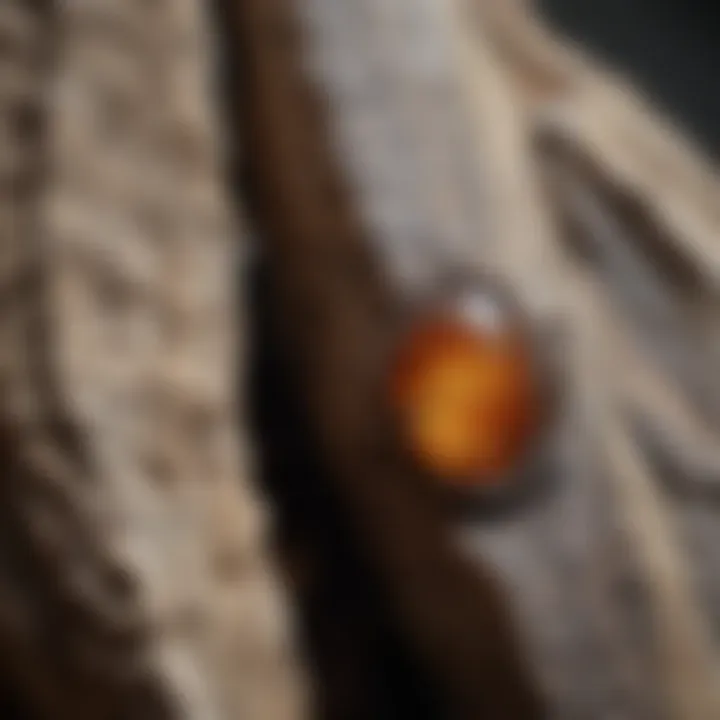
What makes elemental variation compelling is its ability to tie a specimen's appearance to the environmental context of its formation. However, it also comes with challenges—for collectors, discerning between naturally occurring variations and those induced through human interaction can be complicated.
In summary, the formation of color streaks in geological samples is an interplay of natural processes that ultimately reveals the rich history embedded within these specimens. Understanding each layer adds to both appreciation and authenticity for collectors.
Types of Color Streaks
Understanding the various types of color streaks present in geological and paleontological specimens is crucial for both collectors and enthusiasts. These streaks not only provide clues about the mineralogical composition of these specimens, but they also enhance their aesthetic value and even inform us about their formation processes. Recognizing the different types helps in evaluating the authenticity and rarity of a specimen, thus making it a significant area of study.
Mineral-Based Streaks
Quartz Streaks
Quartz streaks are a prime example of color streaks formed by mineral processes. One of the defining characteristics of quartz is its high durability and resistance to weathering, which makes it a prevalent mineral in various natural formations. The transparency of quartz streaks can present a captivating visual effect that is particularly prized among collectors. The unique feature of quartz streaks lies in their ability to refract light, creating an array of colors depending on the impurities present or the conditions under which they formed.
This makes quartz streaks a popular choice because they can add considerable visual appeal to a collection, while also serving as indicators of the geological history. However, the durability of quartz does have its downsides; for instance, while it can withstand harsh conditions, it often lacks vibrant hues compared to other minerals. This might deter some collectors seeking specimens with bolder colors.
Calcite Variations
Calcite variations, on the other hand, bring another layer of intrigue to the study of color streaks. Known for its diverse color palette ranging from milky white to deep oranges and greens, calcite often reflects the process of crystallization in geological settings. The key characteristic that sets calcite apart is its ability to form numerous crystal shapes, which not only exhibit stunning visual appeal but also provide insight into the conditions of their formation.
Calcite can create streaks that are equally vibrant as they are variable, making it a widely sought after mineral in collections. Its unique capacity to fluoresce under ultraviolet light also makes it interesting and interactive. However, one must handle calicite streaks with care because they can be softer than quartz, making them susceptible to scratches or damage during display or transport.
Organic Streaks
Fossilized Remnants
Moving into organic streaks, fossilized remnants are a striking aspect that contribute significantly to our understanding of past life on Earth. When remnants of ancient organisms become fossilized, they might carry colors due to the mineralization process they undergo. The key characteristic of fossilized remnants is their ability to tell a story of biological history, providing insights into the environment and geographical changes over time. Such streaks hold scientific significance as well as collectible appeal.
Fossilized remnants often showcase natural patterns that reflect the organism’s life, and they can be a window into the ecological past. However, collectors may face challenges in identifying the authenticity of these streaks, as some marketing practices may blur the lines between genuine fossils and replicas.
Bio-Induced Coloration
Bio-induced coloration encompasses another fascinating angle in the realm of organic streaks. This phenomenon occurs when living organisms, such as algae or certain bacteria, affect the mineral composition of the surrounding materials. The result can be incredibly intricate color streaks reminiscent of a painter's brushstroke across a canvas. The key characteristic of bio-induced colorations is their often unpredictable and varied nature, making each specimen unique.
These streaks have broader implications, as they can provide information about ancient ecosystems and mineral interactions. As intriguing as they are, discovering and validating bio-induced colorations can be complex, and the subtleties might require expert knowledge.
In summary, the types of color streaks found in geological and paleontological specimens reveal much about their origins. Collectors must navigate the complexities of mineral-based and organic streaks and their unique characteristics while being vigilant about authenticity.
Understanding these aspects not only enriches one's collection but also deepens appreciation for the natural processes that create these stunning features.
Significance of Color Streaks in Collecting
Color streaks hold a special place in the realm of geology and paleontology, particularly for those who have an eye for collecting. These streaks are not just random lines of color; they tell a story about the mineral composition, formation processes, and authenticity of a specimen. Whether a seasoned collector or a curious newcomer, understanding the significance of these streaks can deepen one's appreciation for the earth's history encapsulated in rocks and fossils.
Aesthetic Appeal
When it comes to collection, the first thing that often catches the eye is the aesthetic value. Color streaks can transform an ordinary rock into a fascinating piece of natural art. The variation in hues, patterns, and intensity, often resulting from mineral content or environmental conditions, evokes a sense of wonder. For instance, a quartz specimen with vibrant pink streaks may leave onlookers enchanted, while a fossilized piece with intricate green shades invites deeper inspection.
Collectors prefer pieces with pronounced streaks, as these additions elevate the visual aspects, making them more desirable for display. The captivating visuals provide a conversation starter, sparking interest not just among collectors but also among casual observers.
Value Assessment
In the world of collecting, value is not merely determined by size or rarity but also by the uniqueness of the specimen's features. Here, color streaks emerge as a critical factor in value assessment. A specimen with distinct streaks can command a higher price, as they might indicate a less common mineral composition or color variation attributed to specific geologic events. For example, a stone with vivid streaks of iron oxide may be more sought after due to its rarity and unique coloration.
Moreover, the context in which these streaks appear also matters. Specimens with streaks originating from ancient geological processes might hold greater value, as they offer insight into earth’s history. Collectors often engage in rigorous appraisals based on these features, understood through study and experience.
Market Trends
The marketplace for geological and paleontological specimens constantly shifts, reflecting trends that are often influenced by public interest and scientific findings. Currently, there’s an uptick in demand for specimens showcasing dynamic color streaks, each embodying a microcosm of geological history.
Collectors today are more inclined to gravitate towards pieces with aesthetic qualities, mixing solid scientific background with beauty. This shift indicates a broader demand for educational aspects tied with aesthetics. Focused displays in galleries and online platforms are drawing interest. Collectors now intelligently curate their collections, aiming for pieces that don’t only catch the eye but also have compelling stories tied to them.
"Color streaks not merely enhance aesthetics but serve as pivotal markers of authenticity, enriching the collecting experience."
As awareness grows surrounding geological and paleontological preservation, market trends will likely continue to evolve, pushing collectors toward more distinctive and informative specimens. This enhances both the purchase experience and the educational insights shared within the collecting community.
Techniques for Streak Identification
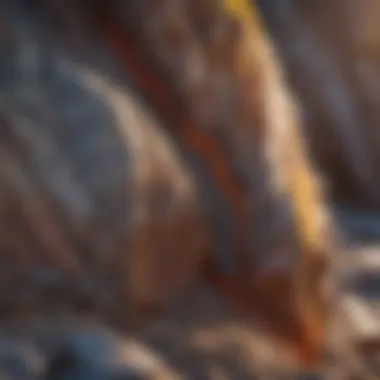
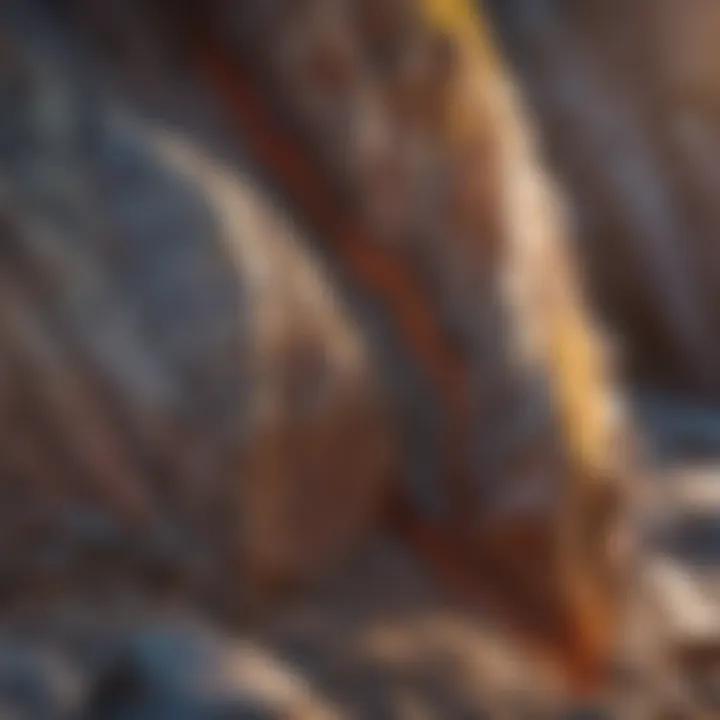
Identifying color streaks in geological and paleontological specimens is no small task. It requires methodical approaches, tapping into both field methods and laboratory analyses. These techniques are the backbone of understanding the composition, authenticity, and even the historical context of these striking colorations. The dual approach of field methods and laboratory analysis allows enthusiasts to gather a well-rounded view of these features. As we dive into the specifics, we will uncover the distinct benefits of each method, their particular characteristics, and considerations that need to be made for effective identification.
Field Methods
Visual Assessments
Visual assessments are often the first line of defense in identifying color streaks. This method relies heavily on the human eye's ability to discern variations in color and texture. One of the key characteristics of visual assessments is their simplicity; no special gear is needed other than a keen observation skill. This makes them particularly beneficial for amateur and professional collectors alike.
What sets visual assessments apart is their immediacy. You can quickly gauge the general hue and shade of a specimen, making it a time-efficient approach. However, the downside is that this method can sometimes lead to subjective interpretations. Different lighting conditions and individual perceptions can skew results, so it should not serve as the sole means of identification.
Streak Testing
Streak testing is another classical method used to identify minerals present in rock and fossil specimens. This technique involves rubbing a specimen across a streak plate, typically made of unglazed porcelain. The resultant streak left on the plate is then analyzed for color. The key characteristic of streak testing is its objectivity; it presents a clear, reproducible result that can be compared across various specimens. This makes it quite popular among collectors and geologists.
Streak testing presents a unique feature in that it often reveals a color that may be different from the specimen's exterior. It can help uncover hidden minerals that are not immediately visible. However, there are limitations. Not all minerals produce a streak, and some may leave inconclusive results. Plus, wear on the streak plate over time can affect accuracy. Nevertheless, it's a cornerstone technique in identifying mineral composition.
Laboratory Analyses
Thin Section Analysis
Thin section analysis is a key technique in modern geology and paleontology. In this method, a very thin slice of the specimen is prepared, allowing geologists to study its crystal structure under a microscope. This method's essential characteristic lies in its precision; it offers a microscopic view that reveals minute details invisible to the naked eye. It's a favored choice in the scientific community for its accuracy.
What distinguishes thin section analysis is the ability to examine features such as grain size, texture, and mineral composition in great detail. The advantage is clear: it takes the guesswork out of identification, providing a reliable snapshot of the specimen's make-up. But with precision comes the drawbacks—preparing thin sections can be labor-intensive and requires specific equipment and training.
Spectroscopic Techniques
Spectroscopic techniques serve as another heavy-hitter in the world of geological analyses. This method employs light to study the properties of minerals. Its primary advantage is that it allows for chemical analysis without needing to physically alter the specimen. Thus, it’s particularly appealing as it maintains the integrity of the sample.
One unique feature of spectroscopic analysis is its versatility. Different spectroscopic techniques can be deployed for various types of assessments, like identifying specific elements or compounds. Nonetheless, these methods can be on the pricier side and may require a skilled technician to interpret the results accurately. In other words, while they offer unparalleled insights, they come at a cost.
To sum up, choosing the right technique for streak identification can significantly impact your understanding and appreciation of geological and paleontological specimens. Both field methods and laboratory analyses contribute rich layers of information, enhancing the collector's experience.
Color Streaks and Authenticity
Understanding color streaks is not merely an aesthetic pursuit or a casual interest; it plays a critical role in validating the authenticity of geological and paleontological specimens. Authenticity in this context relates to the verification that an item is not only genuine, but also representative of its claimed origin and composition. This aspect is crucial for rock and fossil collectors, as the integrity and value of a specimen often hinge on its authenticity.
Color streaks can serve as indicators of an item’s provenance. They can help distinguish between naturally occurring specimens and those artificially altered or enhanced. In a market rife with fakes, recognizing the telltale signs of authenticity related to color streaks becomes indispensable. Notably, these indicators can include the consistency of coloration, the patterns observed within the streaks, and even the historical context regarding the specimen’s formation.
Indicators of Authenticity
When assessing the authenticity of a specimen, several key indicators can be inferred from its color streaks:
- Color Consistency: Natural specimens typically exhibit color variations that are consistent with geological processes. If the color appears unnaturally uniform, it could indicate artificial enhancement.
- Pattern Analysis: The patterns created by color streaks in minerals and fossils often carry signatures of their formation processes. Unusual patterns might suggest tampering.
- Comparative Study: By comparing specimens with known origins, collectors can discern patterns that align with recognized geological or biological characteristics, lending credibility to the authenticity of their finds.
- Historical Documentation: Often, historical accounts or scientific literature will document specific specimens and their characteristics. This can be useful in validating authenticity through color streak patterns understood within a historical context.
As collectors delve deeper into these nuances, it becomes clear that color streaks are not just a superficial trait; they are a window into the geological past that can confirm or deny a specimen's legitimacy.
Counterfeit Identifications
The unfortunate reality for collectors is the prevalence of counterfeit specimens in the market. However, understanding how color streaks can help identify these fakes is key to avoiding pitfalls. Here’s how:
- Surface Treatments: Many counterfeits are treated to mimic the appearance of color streaks found in authentic specimens. Investigations might reveal unnatural layering or paint-like textures that don’t match natural formations.
- Microscopic Examination: Utilizing microscopic techniques can reveal inconsistencies in the mineral structure, which often contrast sharply with the streaks present in authentic specimens.
- Chemical Analysis: Advanced methods such as X-ray fluorescence (XRF) can provide a definitive look at the elemental composition of a specimen. Counterfeit samples often don't match the expected chemical signature of genuine pieces.
"A well-informed collector can navigate the treacherous waters of specimen buying with knowledge of how authenticity can be assessed through color streaks."
- Professional Appraisals: Engaging with experts in mineralogy or paleontology can provide an additional layer of assurance. Professionals bring both knowledge and experience to the table, often spotting subtle discrepancies that the untrained eye may overlook.
Ultimately, recognizing and understanding color streaks provides a valuable skill set for collectors. It puts power back into their hands, enabling them to make informed decisions and enrich their collections with confidence.
Cultural and Educational Implications
Understanding the cultural and educational implications of color streaks in geology and paleontology is vital for appreciating their broader significance. These color variations not only tell tales of the earth's age and the environmental conditions that existed millions of years ago, they also bridge the ancient and modern worlds. Color streaks serve as a medium through which art, folklore, and scientific inquiry converge, highlighting the necessity of a more interdisciplinary approach to studying natural specimens.
Educational Value in Geology
In geology, color streaks can enhance the learning experience, allowing students and collectors alike to visualize mineral compositions and geological processes. When students see vivid streaks on rocks or fossils, it can spark curiosity and deepen understanding. Educators can exploit these visual cues to explain complex concepts, such as mineral formation or sedimentary layering.
Moreover, incorporating color streak analysis into educational curricula could foster a more hands-on approach. For example, students could engage in field studies where they collect samples, record streaks, and analyze them back in the classroom. This active participation often leads to a richer learning experience, where concepts go beyond textbook definitions and become tangible.
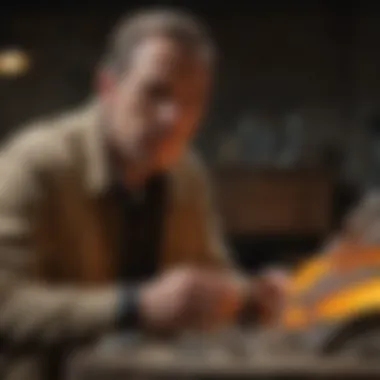

Cultural Interpretations of Color
Color is not just a physical characteristic; it carries weight in cultural narratives and artistic expressions.
Symbolism in Art
Symbolism in Art is a powerful way to convey ideas and emotions. Here, shades and hues can represent everything from sorrow to joy, life to decay. For instance, earthy tones often evoke a sense of grounding and connection to nature, making them popular in pieces that aim to highlight environmental themes. This artistic representation helps audiences connect emotionally with the subject matter, nurturing a sense of appreciation for the earth's history.
A notable characteristic of color symbolism in art is its subjectivity; different colors resonate uniquely with individuals. This uniqueness can spark dialogue among collectors about the historical and geographical significance of certain hues in their pieces. By painting color as more than just decoration, it serves as a language, making art a beneficial element of this article.
On the flip side, reliance on colors to express ideas can sometimes lead to misunderstandings. Not every viewer may interpret colors in the same way, which can dilute the intended message of a work. Yet, even these challenges provide avenues for exploration, making Symbolism in Art a rich discussion point.
Folklore Associations
Folklore Associations add yet another layer to our understanding of color in geological and paleontological specimens. Many cultures have myths and stories tied to specific colors found in nature. For example, indigenous narratives often include references to how the colors of stones depict stories of creation or transformation. This aspect makes folklore a fascinating subject for those interested in how cultural narratives influence scientific interpretation.
A key characteristic of folklore is its ability to change and evolve while still honoring tradition. This adaptability makes it a compelling choice for this article on color streaks. The stories surrounding these colors contribute to the significance of the specimens beyond mere collection, imbuing them with cultural value.
However, the challenge of folklore associations lies in their variability; what one culture might celebrate, another may dismiss. Despite this, understanding these cultural differences opens a window into the diverse perspectives that enrich this discourse, making Folklore Associations a benefit rather than a hindrance to our overall exploration.
Collecting and Preserving Color Streaks
The act of collecting and preserving color streaks holds a pivotal role in both geology and paleontology. For enthusiasts and collectors alike, these unique markings can tell stories about the earth's history and a specimen’s authenticity. Color streaks not only enhance the visual allure of specimens but also provide crucial information for classification and valuation. When collectors pay attention to these aspects, they enrich their experience and understanding of the natural world.
Storage Techniques
Effective storage techniques are vital in ensuring that these natural marvels remain undamaged and retain their vibrancy. This involves not just physical storage, but understanding the conditions that maintain their integrity.
Display Cases
When talking about display cases, one immediate thought is how beautifully they showcase specimens. The key characteristic of display cases is that they protect the collection from dust, humidity, and physical damage while allowing for visibility. Many collectors prefer acrylic cases because they offer clarity and durability.
One unique feature of high-quality display cases is the UV-filtering glass. This glass protects the color streaks from fading due to sun exposure. However, one drawback could be availability; sometimes, finding the right size or style might turn into a hunt. Yet, those who invest in solid display solutions often note their benefits. Display cases create an organized and professional look, significantly enhancing the overall experience of viewing these geological and paleontological treasures.
Climate Control
Climate control takes a broader approach, focusing on overall environmental conditions. Its characteristic lies in maintaining consistent temperature and humidity levels, which is crucial for preserving both minerals and organic materials. In many cases, collectors turn to climate-controlled cabinets or rooms to provide stable conditions.
One unique feature worth mentioning here is data loggers that monitor the environment. This high-tech option can signal when conditions veer away from ideal ranges. However, it does require some initial investment and regular checking. Despite the limitations, the value of preserving color streaks through controlled environments cannot be overstated. It ensures that delicate materials retain not just their structural soundness but also their visual appeal over time.
Restoration Efforts
Restoration efforts become essential when a specimen shows signs of wear or damage. Collectors often face the dilemma of whether to restore or leave a specimen in its natural state. Restoration can involve cleaning, repairing cracks, or even reintegrating loose fragments. The aim here isn’t just to make a specimen visually appealing but also to ensure its integrity as a piece of scientific history.
"The integrity of color streaks must be maintained, as they often hold the key to not just the aesthetic but also the context in which the specimen was formed."
Collecting and preserving color streaks is more than a hobby; it's an enriching endeavor that ties together science, history, and art. By following proper storage techniques and understanding restoration efforts, collectors empower themselves to maintain these valuable artifacts for future generations.
Future Research Directions
The exploration of color streaks in geology and paleontology presents multiple avenues for ongoing research and discovery. These streaks, while often underestimated, can yield critical insights into the geological history and biological processes that shape our planet. Understanding the specifics of these color variations not only enhances our grasp of mineral composition and authenticity but also offers broader implications for scientific inquiry and the field of collecting.
Innovative Techniques in Analysis
As technology advances, innovative techniques are emerging that promise to revolutionize how we analyze color streaks. Methods such as X-ray fluorescence (XRF) and laser ablation inductively coupled plasma mass spectrometry (LA-ICP-MS) allow for high-precision analysis of elemental compositions within specimens.
These modern analytical methods offer several benefits, including:
- Increased Precision: The ability to identify trace elements with extreme accuracy helps in distinguishing between similar-looking minerals.
- Non-Destructive Testing: Many of these techniques analyze specimens without causing damage.
- Rapid Results: Researchers can gain valuable insights much faster than traditional methods allow.
For instance, utilizing XRF can reveal subtle variations in the mineralogy of a rock sample, thereby helping paleontologists understand the environmental conditions when the organism existed. These connections provide a clear picture of ecological shifts over time, enriching the narrative behind each specimen.
Broader Implications for Collecting
The significance of color streaks stretches far beyond their aesthetic charm. For collectors, a deeper understanding of these colored patterns can lead to better-informed decisions when acquiring specimens.
Consider the implications:
- Enhanced Authenticity: Knowledge about how to discern genuine specimens from counterfeits through color analysis can protect collectors from fraud.
- Market Appreciation: As the community comprehends the geological narratives that color streaks tell, the market value of these specimens can fluctuate significantly. Collectors armed with this information may find themselves in a better position financially and ethically.
- Cultivating a Connoisseur Culture: An informed collector base leads to a community more invested in education, preservation, and responsible collecting practices.
"Knowledge is the atmosphere in which creativity thrives; the deeper we dive into the world of color streaks, the more connections we uncover." - An enthusiastic collector
The journey into understanding color in geological specimens is just beginning, and the path ahead is ripe for exploration.



